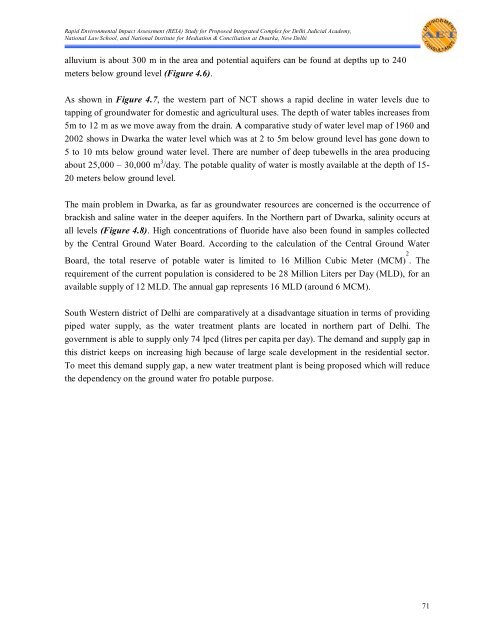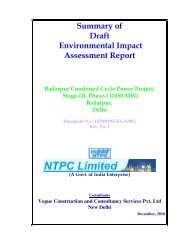proposed integrated complex for delhi judicial academy
proposed integrated complex for delhi judicial academy
proposed integrated complex for delhi judicial academy
Create successful ePaper yourself
Turn your PDF publications into a flip-book with our unique Google optimized e-Paper software.
Rapid Environmental Impact Assessment (REIA) Study <strong>for</strong> Proposed Integrated Complex <strong>for</strong> Delhi Judicial Academy,<br />
National Law School, and National Institute <strong>for</strong> Mediation & Conciliation at Dwarka, New Delhi<br />
alluvium is about 300 m in the area and potential aquifers can be found at depths up to 240<br />
meters below ground level (Figure 4.6).<br />
As shown in Figure 4.7, the western part of NCT shows a rapid decline in water levels due to<br />
tapping of groundwater <strong>for</strong> domestic and agricultural uses. The depth of water tables increases from<br />
5m to 12 m as we move away from the drain. A comparative study of water level map of 1960 and<br />
2002 shows in Dwarka the water level which was at 2 to 5m below ground level has gone down to<br />
5 to 10 mts below ground water level. There are number of deep tubewells in the area producing<br />
about 25,000 – 30,000 m 3 /day. The potable quality of water is mostly available at the depth of 15-<br />
20 meters below ground level.<br />
The main problem in Dwarka, as far as groundwater resources are concerned is the occurrence of<br />
brackish and saline water in the deeper aquifers. In the Northern part of Dwarka, salinity occurs at<br />
all levels (Figure 4.8). High concentrations of fluoride have also been found in samples collected<br />
by the Central Ground Water Board. According to the calculation of the Central Ground Water<br />
Board, the total reserve of potable water is limited to 16 Million Cubic Meter (MCM) 2 . The<br />
requirement of the current population is considered to be 28 Million Liters per Day (MLD), <strong>for</strong> an<br />
available supply of 12 MLD. The annual gap represents 16 MLD (around 6 MCM).<br />
South Western district of Delhi are comparatively at a disadvantage situation in terms of providing<br />
piped water supply, as the water treatment plants are located in northern part of Delhi. The<br />
government is able to supply only 74 lpcd (litres per capita per day). The demand and supply gap in<br />
this district keeps on increasing high because of large scale development in the residential sector.<br />
To meet this demand supply gap, a new water treatment plant is being <strong>proposed</strong> which will reduce<br />
the dependency on the ground water fro potable purpose.<br />
71
















